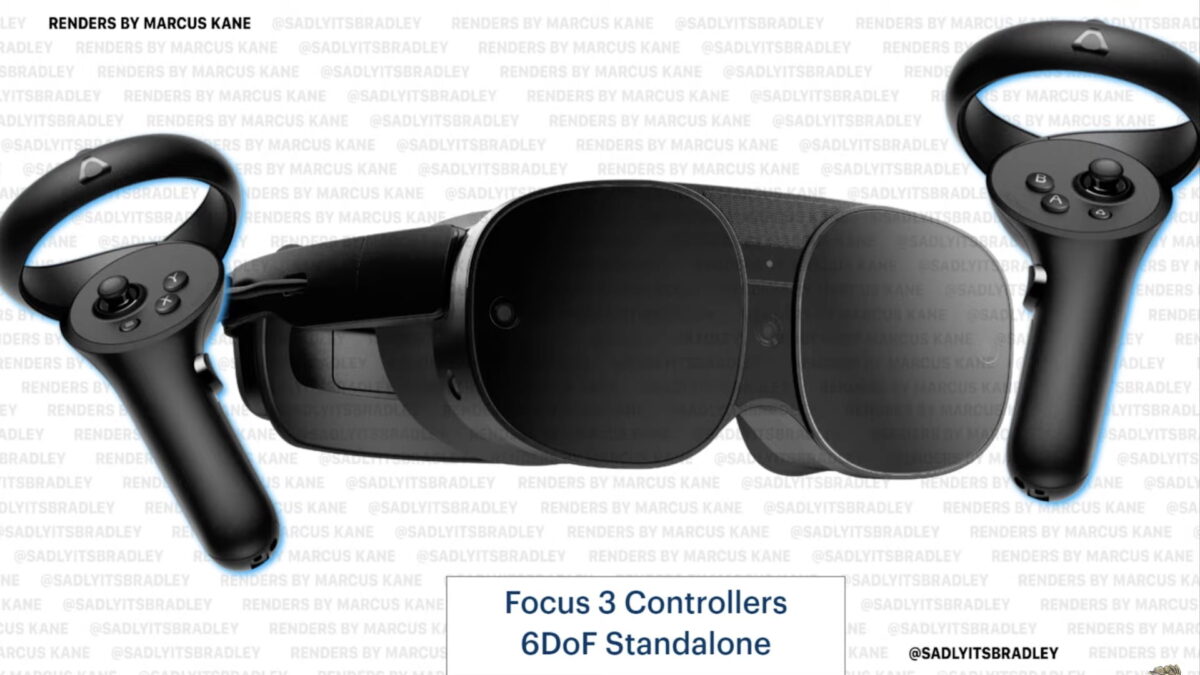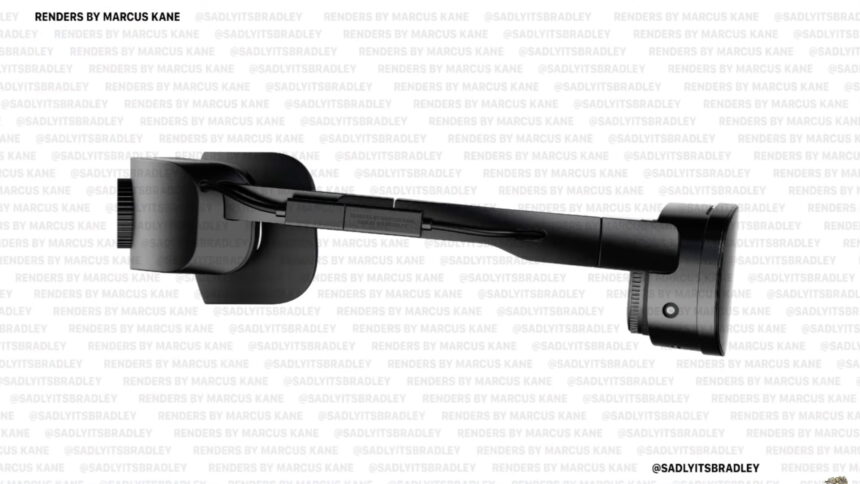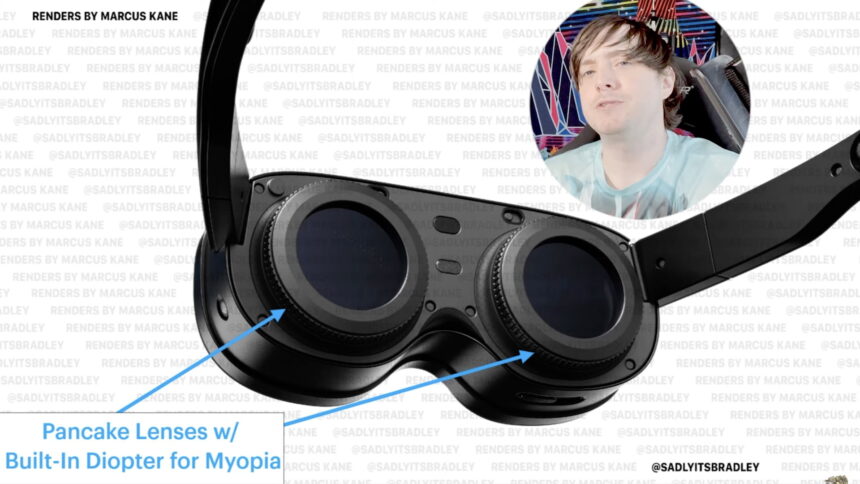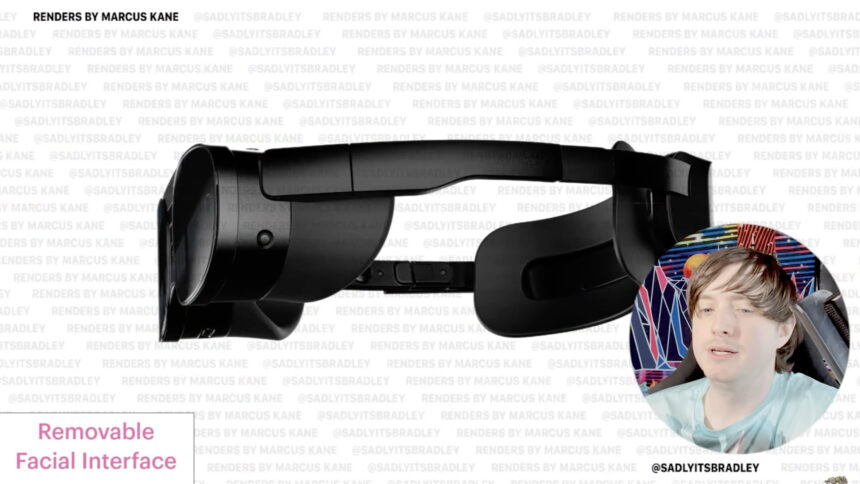New HTC Vive headset leaked: Fast, slim and modular

Lynch made significant corrections to his HTC leak via Twitter after new sources approached him:
- The device is aimed at prosumers instead of consumers and is expected to cost more than $1,000.
- It includes a depth sensor above the 16MP RGB camera.
- It uses an actively cooled Snapdragon XR2 Gen 1 with 8GB of RAM instead of a next-gen chip.
- A module for face and eye tracking is planned and will follow at a later date.
HTC has been hinting at a new VR headset for weeks. Youtuber Brad Lynch claims to have leaked the design and technology.
Lynch reached out to industry sources, particularly those in the supply chain, and got his hands on photos of the VR headset. To protect the sources of the leak, Lynch had 3D designer Marcus Kane create renders of the device based on those photos. Lynch has worked with Kane before on his Quest Pro leaks.
Since the photos leaked to Lynch do not show the headset from all sides, Kane had to take design liberties in certain areas.
A mix of Vive Flow and Vive Focus 3
HTC's new headset doesn't have a name yet. Lynch calls it the HTC Vive "Flowcus" because the device combines the design and slim form factor of the HTC Vive Flow with the technical performance of the HTC Vive Focus 3 (review).
The casing is visually reminiscent of the Vive Flow and has pancake lenses like the latter, so the headset itself is rather slim.
Technically, however, the device is much more powerful: It works completely independently like the Vive Focus 3.
Vive Flow still required a smartphone as a pocket PC. In addition, the integrated SoC is "much faster" than the Snapdragon XR2 Gen 1, which works in Meta Quest 2 and Vive Focus 3, among others, according to Lynch's sources.

The device has a rather slim front thanks to pancake lenses. | Bild: SadlyitsBradley / Marcus Kane
Lynch's sources could not confirm exactly which chip it is. The most likely candidate is the Snapdragon XR2 Gen 2, which is rumored to be unveiled tonight. It could offer up to three times as much graphics performance as the last-generation chip.
HTC Vive "Flowcus" is a full 6-DoF headset, Lynch said. The Vive Focus 3 controllers are used as input devices. Vive Flow was also 6-DoF, but only offered a 3-DoF smartphone controller.
New Vive headset offers color passthrough and diopter adjustment
Similar to the Pico 4, HTC's new headset has four tracking cameras and an RGB sensor integrated. The HTC Vive "Flowcus" is supposed to offer color passthrough. The VR headset has two integrated LC displays with a resolution of 1,920 by 1,920 pixels that run at a maximum refresh rate of 120 hertz.

Use the dials to set your own diopter value. | Image: SadlyitsBradley / Marcus Kane
The HTC Vive "Flowcus" adopts perhaps the best feature of the HTC Vive Flow: a visual acuity adjustment directly on the lenses that lets you set your diopter number, eliminating the need to wear a headset or contact lenses.
Unlike the HTC Vive Flow, the lens distance can also be adjusted via a physical slider. For full VR immersion, you can attach a light shield to the casing.
New HTC headset supports PC and USB-C connection
One of the most interesting features of the HTC Vive "Flowcus" is its modular design: The rear part of the head mount, which also contains the battery, can be removed.
This allows the device to be used as particularly lightweight glasses for on the go, which can be connected to an external player (such as a smartphone or PC) via a USB-C cable (see cover picture). In this "glasses mode", the temples can be folded down like real glasses. The sound comes from integrated stereo speakers.

Optional light blockers are available for full VR immersion. | Image: SadlyitsBradley / Marcus Kane
Lynch further reports that the HTC Vive "Flowcus" has a USB-C port. This could be intended for eye and face tracking modules, similar to the Vive Focus 3, which would allow the headset to be upgraded with hardware features later on.
According to Lynch's sources, the device will be launched in early 2023 and will have a price tag for consumers.
Since HTC is not known for subsidizing hardware, the headset will probably not be cheap anyway. According to Lynch's insiders, the price will be less than $1,000. HTC could unveil the device in January at CES 2023.
Note: Links to online stores in articles can be so-called affiliate links. If you buy through this link, MIXED receives a commission from the provider. For you the price does not change.